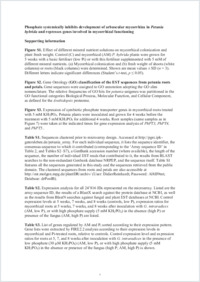Phosphate systemically inhibits development of arbuscular mycorrhiza in Petunia hybrida and represses genes involved in mycorrhizal functioning
- Breuillin, Florence Department of Biology, University of Fribourg, Switzerland - Boyce Thompson Institute for Plant Research, Ithaca, USA
- Schramm, Jonathan Department of Biology, University of Fribourg, Switzerland
- Hajirezaei, Mohammad Leibniz-Institute of Plant Genetics and Crop Plant Research, Gatersleben, Germany
- Ahkami, Amir Leibniz-Institute of Plant Genetics and Crop Plant Research, Gatersleben, Germany
- Favre, Patrick Department of Biology, University of Fribourg, Switzerland
- Druege, Uwe Leibniz-Institute of Vegetable and Ornamental Crops, Grossbeeren, Germany
- Hause, Bettina Leibniz-Institute of Plant Biochemistry, Halle, Germany
- Bucher, Marcel University of Cologne, Botanical Institute, Köln, Germany
- Kretzschmar, Tobias Institute of Plant Biology, University of Zürich, Switzerland
- Bossolini, Eligio University of Berne, IPS, Switzerland
- Kuhlemeier, Cris University of Berne, IPS, Switzerland
- Martinoia, Enrico Institute of Plant Biology, University of Zürich, Switzerland
- Franken, Philipp Leibniz-Institute of Vegetable and Ornamental Crops, Grossbeeren, Germany
- Scholz, Uwe Leibniz-Institute of Plant Genetics and Crop Plant Research, Gatersleben, Germany
- Reinhardt, Didier Department of Biology, University of Fribourg, Switzerland
-
04.11.2010
Published in:
- The Plant Journal. - 2010, vol. 64, no. 6, p. 1002-1017
English
Most terrestrial plants form arbuscular mycorrhiza (AM), mutualistic associations with soil fungi of the order Glomeromycota. The obligate biotrophic fungi trade mineral nutrients, mainly phosphate (Pi), for carbohydrates from the plants. Under conditions of high exogenous phosphate supply, when the plant can meet its own P requirements without the fungus, AM are suppressed, an effect which could be interpreted as an active strategy of the plant to limit carbohydrate consumption of the fungus by inhibiting its proliferation in the roots. However, the mechanisms involved in fungal inhibition are poorly understood. Here, we employ a transcriptomic approach to get insight into potential shifts in metabolic activity and symbiotic signalling, and in the defence status of plants exposed to high Pi levels. We show that in mycorrhizal roots of petunia, a similar set of symbiosis-related genes is expressed as in mycorrhizal roots of Medicago, Lotus and rice. Pi acts systemically to repress symbiotic gene expression and AM colonization in the root. In established mycorrhizal roots, Pi repressed symbiotic gene expression rapidly, whereas the inhibition of colonization followed with a lag of more than a week. Taken together, these results suggest that Pi acts by repressing essential symbiotic genes, in particular genes encoding enzymes of carotenoid and strigolactone biosynthesis, and symbiosis-associated phosphate transporters. The role of these effects in the suppression of symbiosis under high Pi conditions is discussed.
- Faculty
- Faculté des sciences et de médecine
- Department
- Département de Biologie
- Language
-
- English
- Classification
- Biological sciences
- License
- License undefined
- Identifiers
-
- RERO DOC 21057
- DOI 10.1111/j.1365-313X.2010.04385.x
- Persistent URL
- https://folia.unifr.ch/unifr/documents/301741
Other files
Statistics
Document views: 98
File downloads:
- rei_psi.pdf: 201
- rei_psi_sm.pdf: 94
- rei_psi_sm_TableS1.csv: 33
- rei_psi_sm_TableS2.csv: 28
- rei_psi_sm_Sheet_Myc_specific_plant_.csv: 25
- rei_psi_sm_Sheet_Myc_specific_fungus.csv: 27
- rei_psi_sm_Sheet_Myc_specific_other.csv: 26
- rei_psi_sm_Sheet_P_induced.csv: 25
- rei_psi_sm_Sheet_Myc_induced.csv: 30
- rei_psi_sm_Sheet_MycP_induced.csv: 25
- rei_psi_sm_Sheet_Myc_repressed.csv: 25
- rei_psi_sm_Sheet_P_repressed.csv: 23
- rei_psi_sm_Sheet_MycP_repressed.csv: 33
- rei_psi_sm-Table-S4.csv: 36
- rei_psi_sm-Table-S5.csv: 30
- rei_psi_sm-Table-S6.csv: 32
- rei_psi_sm-Table-S7.csv: 28


